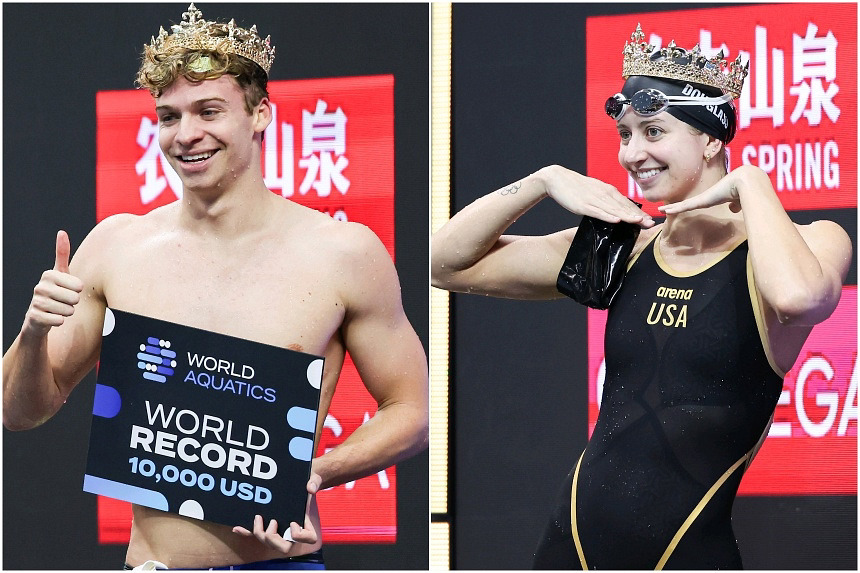
Leon Marchand and Kate Douglass celebrate their victories at the World Aquatics Swimming World Cup on November 1. Kevin Lim
On October 18, the top swimmers from around the globe came together for the World Aquatics Swimming World Cup. The event was packed with crowns, cash, and excitement, as several fan favorites from the Olympics carried their momentum and broke a number of records.
This year’s Swimming World Cup acts as a qualifying event for the World Aquatics Swimming Championships, which will be held in Budapest from December 10 to 15. The structure for the Swimming World Cup is a bit different than other major swimming events. The World Cup consists of three separate meets in three separate cities, each being three days long. The cities this year are Shanghai, Incheon, and Singapore. Prior to the COVID-19 pandemic, the World Cup consisted of seven meets spread across seven cities. Each stop of the World Cup has the same events, meaning that each swimmer will swim the same event multiple times over the course of the entire World Cup. A major difference from other swim meets is that the Swimming World Cup uses a point-based system, something that many fans are not used to, especially following the straightforward medal counts of the Paris Olympics. For each individual event, the finalists (top eight fastest swimmers) will be awarded points that represent their ranking; ten points for first, eight points for second, six points for third, and the number then decreases by one for each finalist, down to one point for eighth place. Each finalist will also be awarded performance points, which are scaled depending on how close a swimmer’s time is to the current world record. Adding the two types of points together will get each swimmer’s final point total for each event. The top three event points are then added together to be a swimmer’s total points in each city, which will allow the establishment of the rankings for women and men at each stop of the World Cup. This ranking dictates the amount of prize money awarded to a swimmer in each city. Finally, totalling the points from all three stops will yield the overall women’s and men’s winners of the Swimming World Cup. In addition to the point system, this year’s Swimming World Cup is being held in a twenty-five meter pool, which is only half the length of an Olympic length pool.
Enough about the rules now, let’s look at some of the major winners from the Cup. The biggest star on the women’s side was American Kate Douglass. Douglass won the Cup on the women’s side with a total of 178.5 points. She won the 50 (meter) butterfly, 100 Individual Medley (IM), and the 200 breaststroke in every stop of the Cup. She also broke the world record for the 200 breaststroke twice. She was followed by fellow American Regan Smith, who set three world records during the Cup; one for the 200 backstroke and two for the 100 backstroke. Third place on the women’s side went to Hong-Kong swimmer Siobhan Haughey, who won the 200 freestyle in all three cities!
The men’s side of the World Cup was packed with broken records as well. French swimmer Leon Marchand went into the meets as a fan favorite, having taken home four gold medals in the Paris Olympics. He remained undefeated in all three cities in the 100 IM, 200 IM, and 400 IM. Marchand also broke Olympian Ryan Lochte’s twelve-year-old world record in the 200 IM, with a time of 1:48.88. Marchand’s impressive times earned him a total of 175.7 points, pushing him to the top among all the male swimmers. Noe Ponti of Switzerland came in second place through his strength as a flyer. He broke the 50 butterfly world record twice during the Cup, and won the 100 butterfly twice as well. Duncan Scott, who represents Great Britain, held strong in the 200 freestyle, remaining victorious in all three cities.
These swimmers alongside dozens of others showcase the pure talent and dedication in the swimming world today. The world is eager to learn who will end up being the top finishers in the upcoming World Aquatics Swimming Championships and who will get their names written into the record books.
